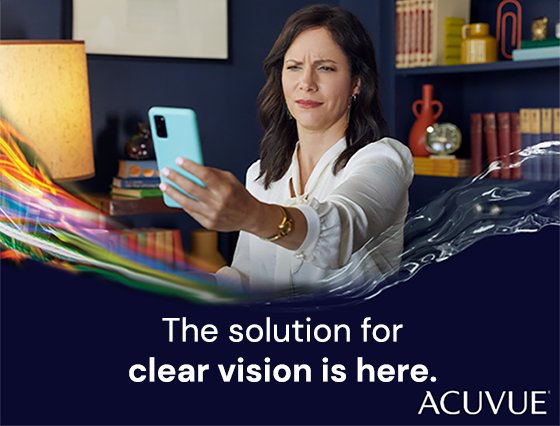Everything you need to know about presbyopia
What is presbyopia?
Presbyopia is the condition when eyes age and have trouble focusing on close objects, for example, while reading or writing. It is often confused with long-sightedness but is not the same as it is caused by age rather than genetic or environmental factors.
The term presbyopia is even based on a Greek word that translates to “old eye”.
Who is at risk?
Everyone will develop presbyopia after a certain age, usually around forty, whether you have healthy eyes, are short- or long-sighted or have astigmatism.
Ageing eyes
The older we get, the more difficult it becomes to read small prints and books at a regular distance. We find ourselves holding books further away, and those who are short-sighted often tilt their heads to look below their corrective glasses or take their glasses off to read. This is normal development and no reason for concern. Presbyopia is easily corrected with reading glasses, prescription glasses or contact lenses.
Is the progression of presbyopia preventable?
No, the progression of presbyopia is not preventable. However, looking after your eye health may slow down or delay the development.
Protecting your eyes after 40
It is important to preserve your eye health at any age, but after the age of forty, you might want to consider further steps to protect your eyes.
Regular eye tests are the best way to ensure that any eye conditions can be spotted as early as possible, such as cataracts or glaucoma, as these might not have any obvious symptoms and go undetected otherwise. Your optometrist can also detect other health conditions during regular eye exams, for example, diabetes or high blood pressure.
Depending on your overall health, your optometrist will recommend how often you should schedule appointments with them.
In addition to regular eye exams, it is also recommended to live on a healthy diet, filled with vegetables and fruit to protect from age-related macular degeneration (AMD).

Causes
The crystalline lens in the eye is responsible for accurate vision over different distances. To do so properly, it needs to be flexible. With age, they lose their flexibility and their eyes become presbyopic.
Hardening of the lens
Although nobody knows what causes presbyopia, it affects everybody. Early in life, the eye lens is flexible, enabling it to adjust its shape as required. This allows us to switch between viewing near to distant objects. During the teen years, however, the lens slowly begins to stiffen and cannot change shape as easily anymore.
The stiffness gradually intensifies over our life and by the time we reach our forties, it begins to cause issues when focusing on close objects. This typically continues to the mid-sixties, when the flexibility is completely lost, and the lens has hardened. At this point, most people will rely on reading glasses, corrective glasses or contact lenses.
Symptoms
If you’re experiencing any of the symptoms below, you might develop presbyopia – particularly if you’re aged 45 or over.
Common signs include:
- Eye strain
- Headaches and/or fatigue
- Difficulty reading text up close
- Holding items such as menus or newspapers at arm’s length to read
How to tell if you have presbyopia
The first sign is that viewing objects up close becomes increasingly more difficult, which most people notice especially while reading.
It can often cause discomfort and the reading material needs to be held further away from the face while the lights need to be turned up brighter.
As the eyes try to accommodate close distances, they may feel tired or strained, which can cause headaches as a result.
An eye test with your optician will tell you whether it is time for you to start using reading glasses.
Diagnosis
Once you experience the first signs of presbyopia, you can contact your optometrist to schedule a sight test and find out your prescription specifications.
During the eye exam
During the eye test, your visual acuity will be checked to determine the severity of your vision difficulties. If you are short- or long-sighted, you will be used to these tests, where you read numbers or letters from a chart.
Following this, the optician will carry out a process called refraction to check your vision through different lenses to find your exact prescription details.
Your local optometrist will already have your records at hand if you are an existing patient and will know what to look out for during the sight test. However, it is always important to mention any other health conditions to your optician, as these may also affect your eye health.

What are the treatment options?
Those who have never had any vision difficulties before developing presbyopia may choose standard reading glasses. However, those who are short- or long-sighted or have a higher level of astigmatism typically have the option between glasses or contact lenses to correct their presbyopia. Always follow your optician’s recommendations to ensure proper vision correction.
Glasses
There are three different types of glasses used to correct presbyopia.
Progressive glasses
Unlike bifocal glasses, progressive lenses don’t have that distracting dividing line between distance and near portions and provide a prescription that gradually changes within a singular lens. They offer the ability to see clearly at all distances, including intermediate vision, which is ideal for looking at a computer screen or the speedometer in your car. As you look through the viewing area of the lens, your vision will be corrected seamlessly no matter the distance. Both the lens and frame can be tailored to you, for a comfortable and natural feel.
Bifocal glasses
Bifocal glasses are divided into two halves with near vision at the bottom part of the lens and distance vision at the top half. Unlike progressive glasses, bifocal glasses have a subtle line on the lens to show the divide between near and distant vision.
Two separate pairs of glasses
Some optometrists may prescribe two separate pairs of glasses, one for distant vision and a second one for reading and close vision. However, this is not the most convenient option as it requires the wearer to always carry two pairs of glasses.
Contact lenses
Those who prefer the light-weight option of contact lenses have two options to correct presbyopia:
Multifocal contact lenses
Multifocal lenses are the most common form of contact lenses for people with presbyopia. Most multifocal contacts are designed with a gradual transition between distance and near prescriptions, giving you the ability to easily focus on objects both far and near.
From playing sports to wearing sunglasses, there are many benefits to contact lenses. They’re particularly useful if you play sports where glasses would be prone to damage or if you’re reading a menu in a restaurant. Pairing contacts with sunglasses is also more cost-effective than buying prescription ones and gives you more freedom in terms of style.
Monovision
Monovision contact lenses correct one eye for distance vision and the other for near vision. It may take a longer time for the brain to adapt to monovision lenses and have a clear depth perception with this option.
Presbyopia prescription measurements
When your vision changes and you receive a new prescription to correct your presbyopia, you will find additional power along with the sphere, cylinder and axis.
How to read the additional power
The additional power is often referred to as ADD or Near ADD and refers to the vision correction required in addition to the usual prescription. The additional power is needed to ensure clear vision at a near distance.



